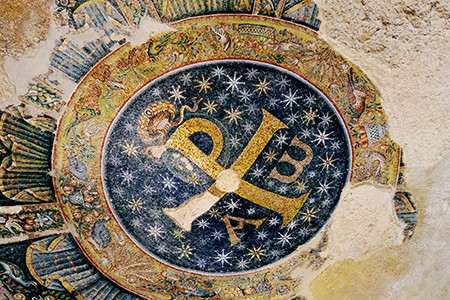My recent work focuses on the study of a series of mosaics and frescoes that adorn the vaulted ceilings of early Christian and early Byzantine religious buildings. The decoration consists of two motifs: the night sky dotted with numerous sparkling stars, and the cross, the symbol of Christ, hovering in the heavens. The composite motif was invented in the last quarter of the fourth century. At that time, erudite church fathers and skilled artists all endeavored to recast the legacy of classical culture within the new framework of Christian belief.
In the East, the Christian renovation is attested by the thought and activity of the Cappadocian fathers, represented by Saint Basil the Great, bishop of Caesarea (330–379). They were grounded in the Greek system of learning, paideia, which, in addition to the liberal arts, included the study of nature. Simultaneously, they inherited the Platonic and Neoplatonic philosophical tradition from the preceding generation and adapted it to new exegetical requirements. Soon the Latin West came under the influence of Greek authors whose works were translated and introduced by such Latin fathers as Saint Ambrose (339–397), bishop of Milan. The dramatic transformation of a pagan to a Christian worldview is vividly described by Saint Augustine in his Confessions.
During my CASVA fellowship, I organized my research into three broad divisions: a catalog of the ten existing monuments with the composite iconography of the cross hovering in the starry sky, interpretation of the iconography, and the historical context of the monuments.
Both the starry night and Christ’s symbol have precedents from before the last quarter of the fourth century. Of the surviving examples, the mosaic decorating the dome of the baptistery of San Giovanni in Fonte in Naples seems to be the earliest. Moreover, it surpasses all the other extant monuments in its superb artistic quality. The mosaicist elaborated the spatial depth of the night sky by skillfully variegating the sizes and colors of the stars. As a result, the symbol of Christ sems to appear abruptly in the dark sky. As seen in the Neapolitan mosaic, the composite iconography is often accompanied by the apocalyptic tetramorph. Scholars have thus unanimously recognized in the mosaic program of San Giovanni in Fonte the Christophany at the end of the world. In doing so, they tended to interpret the two motifs separately and paid little attention to scrutinizing the essential idea by which they are combined. It was Carl-Otto Nordström who, in 1953, noted the vertical structure of the mosaic program of the so-called Mausoleum of Galla Placidia. He compared it to a Parousia image in the Christian Topography of Cosmas Indicopleustes (Vat. Cod. Gr. 699, fol. 89r). However, the manuscript illustration differs decisively from the mosaic in that the Pantocrator seated on the throne occupies the summit of the composition, and his background is painted in solid cerulean blue, without star motifs.
One of the most important literary explanations of the intrinsic meaning of the starry sky is found in Saint Basil the Great’s late work, Hexameron. The significant section for my discussion is his Third Homily on the Firmament. Basil faithfully follows scripture (Genesis 1:6) in describing the firmament as separating the waters below and above it. Despite his exegetical approach to the Heaven of Heavens, or Third Heaven, of scripture, he tries to explicate the nature of the firmament at length by traditional (Hellenistic-Roman) natural science. While discussing the shape of the firmament, he notes that its essence is water, which gains solidity as it is frozen but turns into invisible vapor when heated.
There is some visual evidence that the firmament represented as the starry sky signified the source of water, especially water from above the most sacred sphere, the Heaven of Heavens. One example is a marble plaque from Aquileia with an engraved image representing a scene of the baptism in Paradise, in which water gushes from the starry sky in a roundel hovering above the head of the baptized. This image suggests an interpretation of a small detail of an ivory panel depicting John the Baptist on the front of the cathedral of Maximianus in Ravenna. Draped like a hanging cloth, streams of water flow from under the feet of the Agnus Dei enframed within a disk held by the Precursor.
The creators of this composite motif of the cross and starry night never intended to depict a scientific schema of the universe. Late antique visuality was thoroughly hodological, that is, fundamentally performative. For coeval viewers, the descent of the cross was an extraordinary, awesome spectacle involving them both physically and cognitively, as the souls of men and women on earth, both dead and alive, were lifted to the highest register of heaven.
